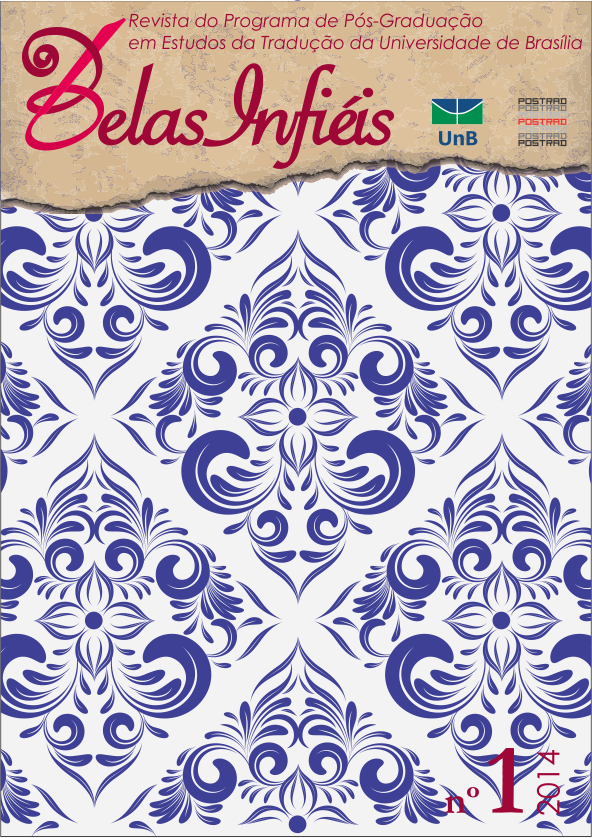A PAISAGEM INDESCRITÍVEL EM HEART OF DARKNESS E DUAS TRADUÇÕES BRASILEIRAS:
UM ESTUDO EXPLORATÓRIO DE ESTILÍSTICA TRADUTÓRIA COM BASE EM CORPUS
DOI :
https://doi.org/10.26512/belasinfieis.v3.n1.2014.11265Mots-clés :
estilística tradutória, estudos da tradução baseados em corpus, tradução literáriaRésumé
Este estudo exploratório e parcialmente guiado pelo corpus investiga traços de estilo no clássico de Joseph Conrad, Heart of Darkness (1902), e duas edições brasileiras, traduzidas por Hamilton Trevisan (1984) e José Roberto O’Shea (2008). A metodologia se apoia na etapa descritiva da “estilística tradutória” de Malmkjaer (2003, 2004) e conta com o auxílio do software WordSmith Tools© 6.0 para o levantamento das linhas de concordância. A investigação se concentra na temática da representação da paisagem como reflexo da perplexidade do observador, conforme apontada em estudos literários e estilísticos sobre o texto original. Em consonância com esses estudos, a análise parte do critério gramatical da negação e, em um segundo momento, observam-se os padrões revelados pelo corpus. Esses padrões apontam para algumas preferências estilísticas dos tradutores e para possíveis mudanças de significado, principalmente no texto de Trevisan, com a intensificação de determinados aspectos da paisagem representada.
Références
BAKER, Mona. Corpus Linguistics and Translation Studies: Implications and Applications. In: BAKER, Mona; FRANCIS, Gill.;TOGNINI-BONELLI, Elena(Eds.), Text and Technology: In Honour of John Sinclair. Amsterdam: John Benjamins, 1993.
______. Towards a methodology for investigating the style of a literary translator. Target, Amsterdam, v. 12, no. 2, p. 241-266,2000.
CONRAD, Joseph. Heart of Darkness. Londres: Penguin Books, [1902] 1994.
______. O Coração da Treva. Tradução de Hamilton Trevisan. São Paulo: Global, 1984.
_____. Coração das Trevas. Tradução de José Roberto O’Shea. São Paulo: Hedra, 2008.
HALLIDAY, Michael. Linguistic Function and Literary Style: An Inquiry into the Language of William Golding’s The Inheritors. In: CHATMAN, Seymour. (Ed.) Literary Style: A Symposium. London & New York:Oxford University Press, 1971.
MALMKJAER, Kirsten. What happened to God and the angels: an exercise in translational stylistics. Target. Amsterdam, v. 15, p. 37-58, 2003.
______.Translational stylistics: Dulcken‘s translations of Hans Christian Andersen. Language and Literature. Londres, v. 13 (1),p. 13-24,2004.
McCLINTOCK, Anne. "Unspeakable Secrets": The Ideology of Landscape in Conrad'sHeart of Darkness. The Journal of theMidwest Modern Language Association. [S.l] vol. 17, n. 1, p.38-53, 1984.
MUNDAY, Jeremy. Style and Ideology in Translation: Latin American Writing in English. New York: Routledge, 2008.
NEVES, MariaHelenade Moura Neves. Gramática de usos do português. São Paulo: EditoraUnesp, 2000.
SALDANHA, Gabriela. Translator style: methodological considerations. The Translator. [S.l]v. 17, n. 1, p. 25-50, 2011.
SCOTT, Nélia. Normalisation and reader’s expectation: a study of literary translation with reference to Lispector’s A hora da estrela.Liverpool, 1998. Tese (Doutorado em tradução literária). AELSU University of Liverpool, Liverpool, 1998.
SINCLAIR, John. Lines about Lines. In: CARTER,R. (Ed.). Language and Literature: An Introductory Reader in Stylistics. London: Allen and Unwin, 1982.
______. Trust the text: Language, corpus and discourse. London: Routledge, 2004.
STUBBS, Michael. Conrad in the computer: examples of quantitative stylistic methods. Conrad, Concordance, Collocation: Heart of Darkness or light at the end ofthe tunnel? Language and Literature. Trier, Alemanha: Universidade de Birmingham,14, 1, p. 5-24, 2003.
Téléchargements
Publié
Numéro
Rubrique
Licence
Copyright Statement
Given the public access to this journal, the texts are free to use but requires the recognition of the original authorship and initial publication in this journal to be properly stated.
The journal allows the use of works published for non-commercial purposes, including the right to submit the work to publicly accessible databases. Published contributions are the sole and exclusive responsibility of the author(s).
- When submitting papers to be evaluated by the Belas Infiéis journal, the author(s):
- Declare that the contents of the contributions are original and of their original creation, being entirely responsible for their content if there is an objection by third parties.
- Claim to be aware that they should not commit academic plagiarism.
- Declare that the manuscript has not been published, completely or partially, in Portuguese or another language. If it is a translation it should be submitted to the Translated Articles section.
- Declare that the manuscript is not being evaluated by other journals.
- Declare that the manuscript was not submitted to another journal simultaneously.
- Commit(s) to inform the journal of any kind of error or inaccuracy in their contribution (published, in evaluation or in editing) and to collaborate with the editors to make due corrections of the article (when in evaluation or editing) or erratum/retraction (after publication).
- Declare that there is no conflict of interest regarding the published work.
- Authorize its release if it is accepted for publication without any kind of monetary compensation.
- Agree to assign non-exclusive rights to publication to the magazine, remaining free to make their contribution available in other media as long as the publication of the first version in Belas Infiéis magazine is mentioned. They also authorize Belas Infiéis to assign their texts for reproduction in content indexers, virtual libraries and similar platforms.
- Maintain copyright and grant the journal the right of first publication, the work being licensed under theCreative Commons Attribution License.
- Is/Are allowed and encouraged to publish and distribute their work online after the editorial process, which may increase the impact and citation of the published work.
- Authorize the editorial team to make textual adjustments and to adapt the article to the publication rules, when necessary.



















